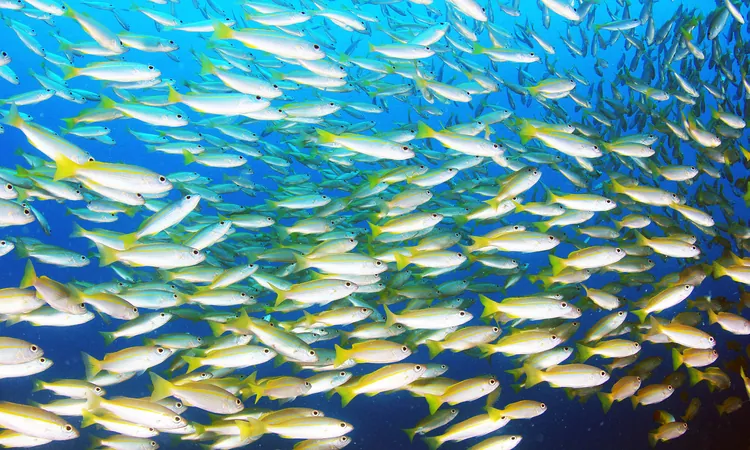
The Ocean's Biggest Predator-Prey Event: A Game Changer for Marine Ecosystems
2024-11-03
Author: Sarah
The Ocean's Biggest Predator-Prey Event: A Game Changer for Marine Ecosystems
In a stunning revelation from the depths of the ocean, scientists have observed what is now considered the largest predator-prey interaction ever recorded, fundamentally altering our understanding of marine food chains. The event, which occurred during the capelin spawning season off the coast of Norway, showcases the complex and often precarious relationships that exist beneath the surface.
The Capelin Migration: A Crucial Journey
Every February, billions of capelin, small Arctic fish akin to anchovies, embark on a monumental journey from the Arctic ice shelf to the Norwegian coast to spawn. This migration is not just essential for the capelin's reproduction; it is also pivotal for the entire Arctic ecosystem, serving as a primary food source for a range of marine species, including larger fish, seabirds, and whales. This seasonal influx of capelin fuels various marine diets and helps maintain the balance of the oceanic food web.
Cod: The Relentless Predators
Typically, the spawning season attracts Atlantic cod, the capelin's primary predators. As thousands of cod tune into the capelin's spawning dance, they seize the opportunity to feast. This annual feeding frenzy is critical for the cod as they build their energy reserves for the year ahead. Yet, the recent findings suggest that this natural cycle can be disrupted, with significant repercussions for marine life.
Innovative Sonic Imaging Technology Reveals Underwater Dynamics
Led by Professor Nicholas Makris from MIT, a team of researchers employed a pioneering sonic imaging technique known as Ocean Acoustic Waveguide Remote Sensing (OAWRS) to study these dynamic interactions deeper than ever before. This technology utilizes sound waves to map the movements of fish and other marine organisms over vast areas, revealing real-time behavior and densities that were previously undetectable.
The ability to differentiate species based on the resonance of their swim bladders added a new dimension to their research. Larger cod produce low-frequency sounds, while smaller capelin resonate at significantly higher frequencies. This groundbreaking technique allowed researchers to observe the capelin as they gathered into enormous shoals mid-spawn.
An Astonishing Encounter
On February 27, 2014, in the midst of spawning season, the researchers witnessed a remarkable sight. As thousands of capelins began swimming deeper, they formed a coherent shoal measuring over six miles long, comprising nearly 23 million individuals. This breathtaking instinctive display demonstrated the capelin's need for density to enhance their survival against predators.
Meanwhile, the cod quickly recognized this massive gathering, forming their own shoal of approximately 2.5 million fish in pursuit. In an awe-inspiring yet daunting battle of survival, the cod consumed over 10 million capelin—more than half of the shoal in mere hours—before returning to their dispersed state.
A Sea Battle Worth Watching
This extraordinary encounter not only marks a record-scale predation event but also reveals the intricate balance of predator-prey relationships crucial for sustaining marine ecosystems. "We are witnessing a coherent battle for survival," said Makris. This simultaneous gathering of prey and predators illustrates how complex these interactions can be, likening the spectacle to a wave of movement akin to fans at a sports stadium.
Implications for Climate Change and Ecosystem Health
While the event represented only a fraction of the total capelin population, it raises alarms regarding climate change impacts. As Arctic ice diminishes, capelins may face longer migrations to reach breeding grounds, thus increasing their vulnerability. Disruption in such vital spawning events can lead to significant ecological consequences, particularly for those species that depend on capelin for their survival.
The researchers emphasize that the health of keystone species like capelin signals potential shifts in the entire marine chain. “When a population is on the verge of collapse, that last shoal can be pivotal. Once it's gone, cascading failures may follow," warns Makris.
The Future of Our Oceans: A Call to Action
Understanding the dynamics of such massive predator-prey events is instrumental for conservation efforts and informed decision-making in marine management. Continuous monitoring and advanced technological applications like OAWRS can help protect marine ecosystems, ensuring the survival of critical species.
In conclusion, this groundbreaking study not only sheds light on the fascinating and often perilous lives of marine fish but also underscores the vital interdependence of ocean life. As we face pressing environmental challenges, these insights remind us of the delicate balance that sustains our oceans and the urgent need to safeguard their future.




 Brasil (PT)
Brasil (PT)
 Canada (EN)
Canada (EN)
 Chile (ES)
Chile (ES)
 Česko (CS)
Česko (CS)
 대한민국 (KO)
대한민국 (KO)
 España (ES)
España (ES)
 France (FR)
France (FR)
 Hong Kong (EN)
Hong Kong (EN)
 Italia (IT)
Italia (IT)
 日本 (JA)
日本 (JA)
 Magyarország (HU)
Magyarország (HU)
 Norge (NO)
Norge (NO)
 Polska (PL)
Polska (PL)
 Schweiz (DE)
Schweiz (DE)
 Singapore (EN)
Singapore (EN)
 Sverige (SV)
Sverige (SV)
 Suomi (FI)
Suomi (FI)
 Türkiye (TR)
Türkiye (TR)
 الإمارات العربية المتحدة (AR)
الإمارات العربية المتحدة (AR)